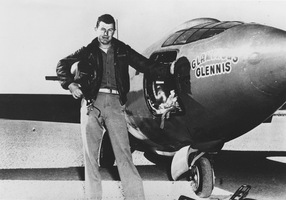 | Back to e-WV
| Back to e-WV
 The West Virginia Encyclopedia
The West Virginia Encyclopedia
 | Back to e-WV
| Back to e-WV
 The West Virginia Encyclopedia
The West Virginia Encyclopedia

General Charles Elwood ‘‘Chuck’’ Yeager (February 13, 1923 – December 7, 2020), the first person to fly faster than the speed of sound, was born at Myra, on upper Mud River about seven miles from the Lincoln County seat of Hamlin. He was the second of five children born to Albert Hal and Susie Mae Sizemore Yeager. The family moved to Hamlin before young Yeager entered the first grade. In 1941, he graduated from Hamlin High School.
Yeager served in Europe during World War II and received his flight training in the military. He enlisted in the Army Air Corps in 1941 at the age of 18, starting out as an airplane mechanic, then enrolling in a flying sergeant program. He enjoyed great success as a fighter pilot, becoming one of the first to down an early German jet with his prop-driven P-51 Mustang. In all, he flew 64 combat missions. Yeager became ‘‘a double ace,’’ with 13 kills. Stationed in England as a fighter pilot, he was shot down on his eighth combat mission on March 5, 1944, while escorting a flight of B-24 bombers. Yeager parachuted into German-occupied France where he hid in a farmer’s barn for several days. Avoiding German patrols, he escaped across the snow-capped Pyrenees into neutral Spain. Upon returning to England, he was met with a rule to keep downed pilots from flying again. He argued his way to a meeting with General Eisenhower, who allowed him to return to his squadron. After he destroyed five German planes during a single historic dogfight in November 1944, Stars and Stripes newspaper ran a headline “Flier Bags 5 Nazi Planes To Vindicates Ike’s Ruling.”
After the war, Yeager remained in the Air Force. On February 26, 1945, Yeager married Glennis Dickhouse, who he had romanced while in flight training in California early in the war, and whose name was on the nose of all his fighters. The couple had four children. Glennis died in 1990 after several bouts with cancer.
After a posting at Wright Patterson Field in Dayton, Ohio, where he flew all the latest jet aircraft available, he became a test pilot in a program at Muroc Army Air Field (now Edwards Air Force Base) that researched high-speed flight. Despite a lack of college education, he was chosen to pilot the secretive X-1 project. On October 14, 1947, in a Bell X-1 rocket airplane dropped from a B-29 bomber, Yeager broke the sound barrier by flying 700 miles per hour, Mach 1.06, at 43,000 feet. He set another speed record on December 12, 1953, by flying two-and-a-half times the speed of sound in a Bell X-1A. Yeager’s X-1, named Glamorous Glennis after his wife, is on display at the Smithsonian’s National Air and Space Museum.
On October 10, 1948, Yeager visited Charleston with a Lockheed P-80 Shooting Star. When he took off from the airport, he flew the jet west down the Kanawha River and under the South Side Bridge during a boat-racing event. Witnessed by the many boaters, audience and news media covering the races, it was never officially reported and has since become a beloved part of the city’s folklore.
Yeager became commander of the Aerospace Research Pilot School at Edwards Air Force Base, California, in 1962. In 1968, he became a brigadier general and in 1971 was assigned as U.S. defense representative to Pakistan. He retired in 1975. Already a hero in military and aviation circles, Yeager catapulted to international celebrity with the publication in 1979 of Tom Wolfe’s novel The Right Stuff and the popular movie which followed the book. Yeager Airport at Charleston is named after General Yeager, as is nearby Yeager Bridge on the West Virginia Turnpike. An academic program for outstanding students at Marshall University, the Yeager Scholars, is named in his honor. On the 40th anniversary of his famous flight, he returned to Hamlin where a life-sized statue was unveiled, and he thrilled the town with a flyover and slow roll in an F-4 Phantom. In 2004, Congress voted to authorize the president to promote Yeager to the rank of major general. In 2005, President George W. Bush granted the promotion of both Yeager and another aviation pioneer, Billy Mitchell.
On October 14, 1997, on the 50th anniversary of his historic flight, Yeager broke the sound barrier again, flying an F-15D Eagle, and the Unites States Postal Service issued a stamp commemorating supersonic flight. On October 14, 2012, on the 65th anniversary of breaking the sound barrier, Yeager did it again in an McDonnell Douglas F-15 Eagle at the age of 89.
Yeager was living in California with his second wife Victoria at the time of his death. He was 97.
e-WV presents West Virginia Public Broadcasting on Chuck Yeager
Written by Tom D. Miller
Yeager, Chuck & Leo Janos. Yeager: An Autobiography. New York: Bantam Books, 1985.
World Book Encyclopedia. .
Wolfe, Tom. The Right Stuff. New York: Farrar, Straus, Giroux, 1979.